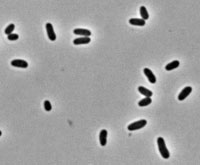Corynebacterium glutamicum
| Corynebacterium glutamicum | ||||||||||||
|---|---|---|---|---|---|---|---|---|---|---|---|---|

Corynebacterium glutamicum |
||||||||||||
| Systematics | ||||||||||||
|
||||||||||||
| Scientific name | ||||||||||||
| Corynebacterium glutamicum | ||||||||||||
| ( Kinoshita et al. 1958) Abe et al. 1967 |
Corynebacterium glutamicum is a gram-positive , non-pathogenic and fast-growing soil bacterium of great biotechnological importance, the genome of which has now been completely sequenced. It was discovered in 1957 in Japan as a natural producer of glutamic acid . In the meantime, fermentative production processes with C. glutamicum and closely related organisms have been developedfor almost all biogenic amino acids and a number of other substances such as nucleotides and vitamins .
Production of glutamic acid
Corynebacterium glutamicum forms L-glutamic acid as a secondary product of the citric acid cycle through the transamination of 2-oxoglutaric acid . The main sources of carbon are molasses or starch hydrolyzate. Ammonia, on the other hand, mostly serves as a nitrogen source.
Biotechnological importance
The mutants used in biotechnology show some changes compared to the freely occurring bacteria. The following should be mentioned in particular:
Increase in the secretion of glutamic acid
The overproduction of glutamic acid depends on the permeability (solid permeability ) of the cell. The more permeable the cell, the more glutamic acid can be released into the surrounding medium. Cell permeability can be influenced by a deficiency in biotin , oleic acid , glycerine or by the addition of penicillin .
Regulation of some enzymes on the biosynthetic pathway
The activity of the enzyme 2-oxoglutarate dehydrogenase is markedly reduced in C. glutamicum strains used biotechnologically in comparison to L-glutamate dehydrogenase . Also, some enzymes are regulated by the concentration of metabolites , end products, NH 4 + and NADH .
Activation of multiple anaplerotic reactions
The carboxylation of phosphoenolpyruvate (PEP) and the activation of the glyoxylate cycle increase the formation of oxaloacetic acid . This represents the precursor of citric acid and can therefore bind further carbon atoms from glycolysis in the citric acid cycle. The enzyme PEP carboxylase , which catalyzes the carboxylation of PEP, also needs biotin , which can then no longer be used to build up the cell wall.
Furthermore, C. glutamicum is used as a non-pathogenic model organism for the related human pathogens Corynebacterium diphtheriae , Mycobacterium tuberculosis and Mycobacterium leprae .
Web links
- http://www.coryneregnet.de Weblink - CoryneRegNet - Database of Corynebacterial Transcription Factors and Regulatory Networks
- http://www.kraemerlab.uni-koeln.de AG Prof. Dr. Krämer, Institute for Biochemistry, University of Cologne
- http://www.fz-juelich.de/ibg/ibg-1/EN/Home/home_node.html IBG1: Biotechnology, Research Center Jülich (member of the Helmholtz Association)